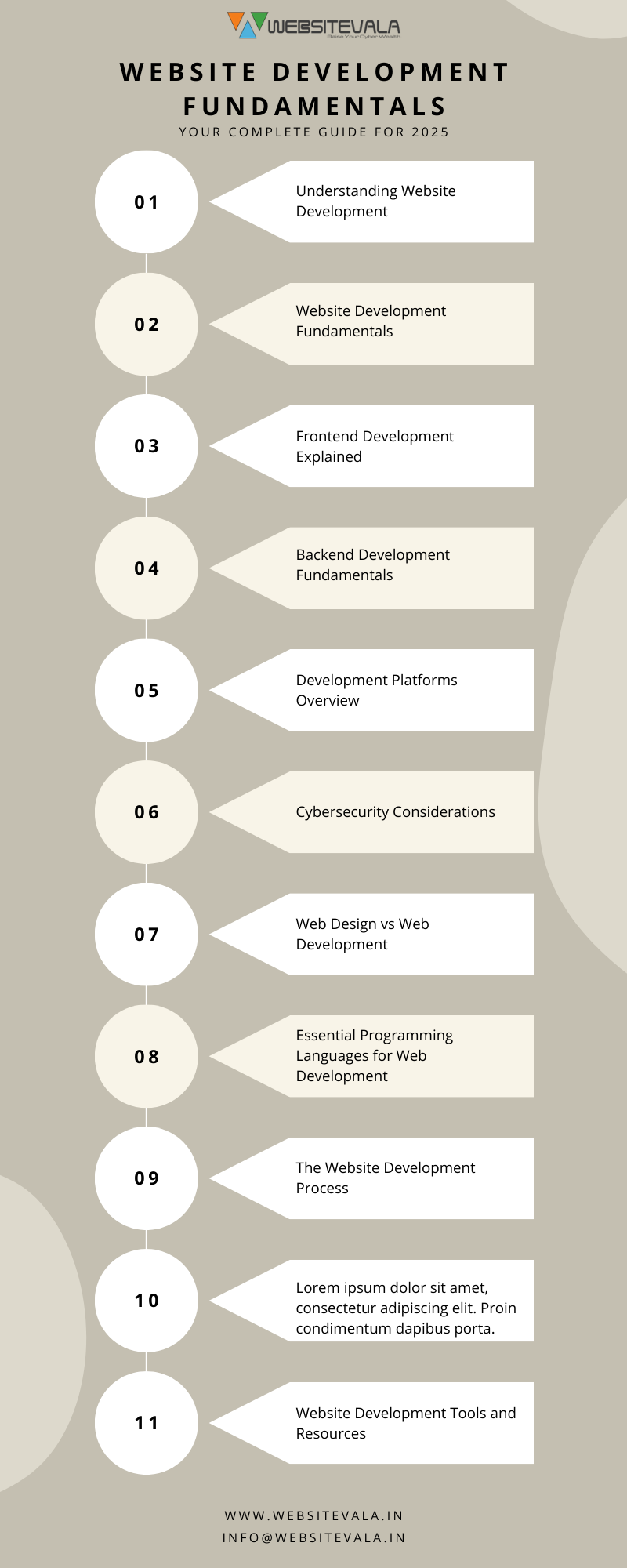Jump Directly to the Topic of Your Interest
Toggle- Key Takeaways
- Understanding Website Development
- Website Development Fundamentals
- Frontend Development Explained
- Backend Development Fundamentals
- Development Platforms Overview
- Cybersecurity Considerations
- Web Design vs Web Development
- Essential Programming Languages for Web Development
- The Website Development Process
- Website Development Tools and Resources
- Website Development Agencies
- Future Trends in Website Development
- Common Website Development Challenges
- Measuring Website Development Success
- Build Smarter, Scale Faster: The Future of Website Development Starts Now
Website development might appear daunting at first glance, but it needn’t be. This comprehensive guide demystifies the process, offering you a clear, step-by-step pathway from initial concept to successful launch. Discover the essential roles, methodologies, and programming languages that drive modern web development in a manner that’s both straightforward and actionable.
The global market for web development is projected to grow from USD 74.69 billion in 2025 to USD 104.31 billion by 2030, maintaining a steady CAGR of 6.91%. This continuous expansion underscores the critical value of digital services across all industries, highlighting why investing in a strong online presence is more essential than ever.
Key Takeaways
- Website development is a collaborative endeavour between designers and developers, combining programming expertise, creative design, and analytical problem-solving to create and maintain websites that are visually compelling, user-friendly, and responsive across all devices.
- The web development process encompasses multiple critical phases: strategic planning, wireframing and prototyping, frontend and backend development, rigorous testing and quality assurance, deployment, and ongoing maintenance—each phase being vital for delivering functional and well-designed digital experiences.
- Essential programming languages for custom website development include HTML for content structure, CSS for styling and layout design, and JavaScript for interactive functionality. Professional website development agencies provide comprehensive services suitable for both small-scale projects and enterprise-level solutions.

Understanding Website Development
Website development serves as the crucial bridge connecting businesses with their customers in the digital realm. It’s the comprehensive process of building and maintaining websites, a discipline that masterfully combines programming expertise, creative problem-solving, and innovative design thinking.
We can conceptualise the web development process as a dual-faceted collaboration between web designers and developers working in harmony. This partnership forges seamless online experiences, where both creative and technical elements come together to build digital platforms that work effectively across all devices.
Core Components of Website Development
Website development extends far beyond merely writing code—it’s about crafting compelling online experiences. This involves ensuring your website is visually striking, user-friendly, and fully optimised through responsive web design.
The design component focuses on user interface (UI) and user experience (UX), whilst programming involves creating the underlying code that powers functionality and performance.
The Role of Web Developers
A web developer’s role is akin to that of an architect—they transform digital blueprints into fully functioning websites. Their responsibilities include coding, debugging, and integrating various features and technologies.
Whether working on frontend interfaces or backend logic, developers play an integral role in both custom website development and ongoing technical support. Their attention to performance, security, and usability ensures users enjoy seamless, fast-loading web experiences.
Website Development Fundamentals
Let’s now break down the key elements that drive the web development process.

What Constitutes a Website?
A website acts as your digital shopfront. Technically, it’s a collection of linked web pages stored on a server and accessible via a browser. Each page features content, imagery, and interactivity that deliver a cohesive user experience.
Understanding IP Addresses
To fully grasp what is an IP address, it helps to think of it as a unique identifier that allows one device to communicate with another over the web.
What is HTTP?
HTTP (HyperText Transfer Protocol) is the foundation for web communication. It governs how data is transferred between servers and browsers, making it essential for seamless web functionality.
The Role of Web Servers
Web servers are the backbone of your site’s visibility. When users enter your domain, the browser requests content from your server, which delivers it instantly. Reliable hosting is essential for uptime, speed, and scalability.
Understanding Coding
Coding translates your design and strategy into a working website. In custom website development projects, developers use structured languages to implement layout, functionality, interactivity, and database logic while keeping SEO fundamentals in mind.
Frontend Development Explained
Frontend development is all about what users see. From intuitive menus to sleek visuals, it prioritises UX and aesthetics. HTML, CSS, and JavaScript are key tools in crafting engaging layouts and responsive behaviours.
Developers here focus on mobile optimisation, accessibility, and responsive web design principles to deliver consistent experiences across all screen sizes.
Backend Development Fundamentals
The backend is the engine that powers your website. It handles database connections, business logic, and server-side operations that users don’t see but rely on.
In larger-scale custom website development projects, backend developers manage security protocols, payment gateways, and content management systems, often using popular PHP frameworks to ensure optimal scalability and performance.
Development Platforms Overview
Development platforms offer frameworks, libraries, and pre-written code modules that speed up the web development process. Popular tools like WordPress, React, and Laravel help teams build robust websites with less effort and greater functionality.
Cybersecurity Considerations

Modern websites must defend against malware, DDoS attacks, and phishing threats. Cybersecurity protocols such as SSL encryption, firewalls, and secure authentication systems are now non-negotiable elements of custom website development.
Web Design vs Web Development
Though closely related, web design and development differ in focus.
The Focus of Web Designers
Web designers are visual strategists. Their role includes:
- Creating intuitive user interfaces
- Selecting typography and colour palettes
- Designing visual content for optimal flow and interaction
The Responsibilities of Web Developers
Web developers transform design into function. Their tasks involve:
- Writing clean, scalable code
- Building interactive features
- Ensuring responsive web design performance
- Managing backend infrastructure
Essential Programming Languages for Web Development
HTML: Structuring Content
HTML is the skeleton of every website. It defines content hierarchy, embeds media, and organises layout, forming the basic structure.
CSS: Styling and Layout
CSS enhances visual appeal. It’s responsible for styling, responsiveness, and animations. It’s indispensable in achieving brand consistency and responsive web design.
JavaScript: Adding Interactivity
JavaScript powers dynamic elements- menus, sliders, modals, and real-time updates. It enhances usability and makes your site feel alive.

The Website Development Process
Every successful website follows a structured web development process:
Planning and Strategy
Define project goals, identify target users, and draft a roadmap. Planning ensures clear direction and alignment.
Wireframing and Prototyping
Visual mock-ups help simulate user journeys and gather early feedback. Wireframes are critical for reducing mid-project errors.
Frontend and Backend Development
Frontend and backend teams build their respective components. Collaboration ensures the site functions well visually and technically.
Testing and Quality Assurance
Every feature undergoes stress-testing for bugs, responsiveness, and cross-browser compatibility. This phase guarantees a polished final product.
Deployment and Maintenance
Once launched, your website enters the maintenance phase, receiving updates, performance tuning, and security checks to remain effective and secure.
Website Development Tools and Resources
Code Editors and IDEs
Tools like VS Code and Sublime Text make writing, editing, and debugging code more efficient, critical for quality custom website development.
Frameworks and Libraries
Using Bootstrap, React, or Angular saves time and ensures code consistency. They’re ideal for speeding up the web development process.
Online Resources and Learning Platforms
Platforms like W3Schools, Coursera, and MDN offer self-paced learning to upskill professionals and beginners alike.
Website Development Agencies
Agencies offer end-to-end services from design to deployment.
Benefits of Professional Development Services
- Advanced coding expertise
- SEO-ready structures
- Mobile-first and responsive web design
- Security audits and updates
- Time-efficient delivery
Choosing the Right Development Partner
When evaluating agencies, consider:
- Technical stack and portfolio
- Pricing transparency
- Maintenance and support plans
- Project communication methods
Looking for the Best Web Development Services?
For bespoke, high-performance websites designed with SEO and scalability at the core, Websitevala’s expert web development team offers the ideal solution. They specialise in responsive design, fast-loading performance, and tailored digital strategies to help businesses thrive online.
Future Trends in Website Development
Progressive Web Applications (PWAs)
PWAs behave like mobile apps but run in browsers, offering faster load times and offline functionality.
Artificial Intelligence Integration
AI is powering personalised content, smart search, and chatbot interactions within the web development process.
Voice User Interfaces
Voice optimisation is rising. Developers now account for voice search and navigation in UX design.
Sustainable Web Development
Eco-conscious coding practices aim to reduce server load, optimise speed, and decrease energy usage.

Common Website Development Challenges
- Cross-browser compatibility: Ensure your site works on all browsers.
- Performance optimisation: Improve loading speed without sacrificing functionality.
- Security: Defend against evolving threats.
- User experience design: Consistently deliver engaging, intuitive UX.
Measuring Website Development Success
Performance Metrics
- Page load speed
- Mobile responsiveness
- Bounce rate
- Search engine visibility
Technical Metrics
- Code quality
- Security compliance
- Cross-device rendering
- Scalability under load
Build Smarter, Scale Faster: The Future of Website Development Starts Now
Website development is both an art and a science, blending creativity with technical acumen. From HTML structure to advanced backend integration, the web development process involves a host of interconnected decisions.
With the help of professional guidance and modern tools, businesses can achieve strong digital foundations that scale. Whether launching your first site or investing in custom website development, staying aligned with responsive web design principles and emerging technologies is key.
Ready to build a fast, reliable website? Contact Websitevala today and let’s build your success story together.


As a digital marketer, SEO lecturer and WordPress developer I support other freelancers and businesses with their websites from helping with the design and blog posts to optimizing them for search engines. I’m the founder of Websitevala and support successful digital marketing companies like ClickDo as a virtual assistant.



